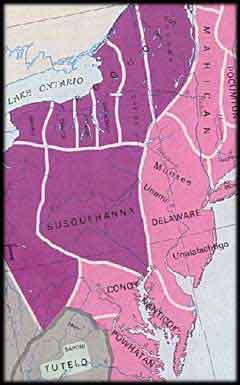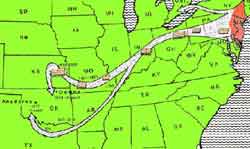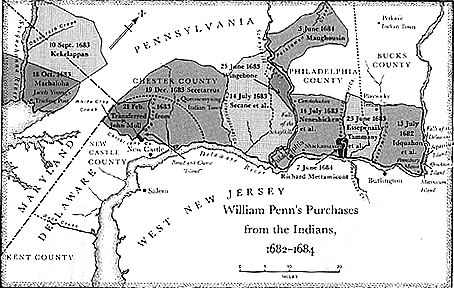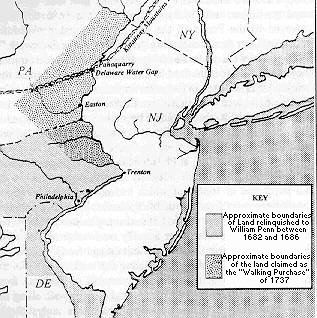
The Treaties
for lands of the Natives in Pennsylvania, and their Effects on our Forebears
aThis
Page is Part of The Subject
Heading: Native
Tribes of Southeastern and Southcentral Pa [See
Subject
Heading's Table of Contents]
aaThe
Subject
Heading is part of The Chapter Entitled
Pennsylvania & Our Pennsylvanians
[See Pa
Chapter
Index]
aaaThe
Chapter
is part of Our
American Immigrants, a section of the Within
The Vines Website [See General
WTVines
Site Map]
Within
The Vines Home *Copyright & Terms
of Use *To Our American
Immigrants
* To Our Europeans *
Email Webmistress
Pa
Chapter Heading Index *Pa History
& Settlement in Brief * Pa
History Gateway Page * Our
Pennsylvanians Title Page
This Page:
A) Intro and
B) Subject Table
of Contents with links to specific tribes and subject detail
C}Sources used for all pages within Subject Title
Treaties
Between the Native Americans and William Penn, the Penn Heirs and
their Agents [including James Logan] , and Involving the Pennsylvania
of our Forebears
Treaties 1682-84
William Penn sought , and obtained, treaties
with the
native Lenape immediately upon acquisition
of the colony.
He sought a treaty with the Susquehannock,
but found they were subjugated by the Iroquois.
Map Image below from Penn
and the Indians page of comprehensive website entitled
" William Penn. Visionary Proprietor"
by Tuomi J. Forrest
The Purchase of Lands West of the Susquehanna
1736 from the Iroquois by the Penns which allowed for European settlement
of "All the land west of the Susquehanna to the setting sun"
The Walking Purchase 1738 which cleared the north eastern and north
central region for European Settlement, alienated, disenfranchised and
cheated the Delaware, and so laid the foundation for their significant
role in harrassing and attacking Pennsylvania's frontier comunities in
the French and Indian War
a
.
|
The Natives at time of contact. By 1682 and Penn's
acquisition and arrival, this map
would be different
 |
|
 |
The Lands of the Lenape on
Contact , and the Migration as a Result [with the Lenape were the Shawnee
and Munsee people]
|
|
|
|
****************************

Treaties 1682-84
William Penn sought , and obtained, treaties
with the
native Lenape immediately upon acquisition
of the colony.
He sought a treaty with the Susquehannock,
but found they were subjugated by the Iroquois.
Map Image below from Penn
and the Indians page of comprehensive website entitled
" William Penn. Visionary Proprietor"
by Tuomi J. Forrest
|
 |
This portion
of Penna history involves the Unami (Turtle Totem)
of the Lenape (or Delaware) tribe ,
the first visit of William Penn to Pennsylvania, and the Delaware
Chief among them , Tammanyfootnote two.
Tammany is the Chief who sold Manhattan
for the famous beads-not to the Dutch, but to the English in 1682.
Swanton writes that
in that year "the most notable event in Delaware history took place
.... when these Indians held their first council with William Penn at what
is now Germantown, Philadelphia.1" .
|
|
Penn came twice to his colony,
and never tarried long within it. His first voyage was in the fall
of 1682, and he left in August of 1684. He returned for a short spell in
1692, and at that time was accompanied by
James Logan [our direct via the
Howard Ascendancy] , a man of modest means who gained employment as
Penn's secretary, functioned as steward of Pennsylvania on behalf
of Penn in Penn's absence, and grew to be the wealthiest man in all the
colonies at his zenith. It is during Penn's first visit to
his colony that Penn supposedly signed a treaty with the Lenni Lenape Indians
at Shackamaxon. No copy of this agreement exists, but there is a
wampum
belt that is said to have been given to Penn by the natives at this
time. Colonial Historian "Francis Jennings believes that Penn signed the
treaty and never broke it, but that his less scrupulous successors destroyed
the document, presumably so that they could renege on its provisions."3.
The earliest treaty document to which we can actually refer is the Treaty
dated July 15, 1682 , in which Penn brokered with Idquahon and several
others amongst the Lenape leadership for land pertaining to them.
In 1683 he brokered more land transactions with these native peoples, while
evidencing undertanding of the Lenape and the Iroqois
Confederacy of New York to whom the Lenape were subjugated. "The
treaty of 1701 is both the first full treaty text that remains extant (there
exist parts of earlier ones), and the last agreement brokered directly
by Penn rather than his agents. It also capped a major power play: 'It
conveyed land, controlled trade, and arranged juridical relationships,
all at the expense of New York and New York's partners, the
Iroquois Five Nations' (Jennings 205). As he had done before, Penn
rewarded 'his' Indians. His policies helped make Pennsylvania, in the words
of the missionary John Heckewelder, 'the last, delightful asylum' for Native
Americans (Jennings, 207). Penn's successors were much less fair and scrupulous
in dealing with the Indians. The ink was barely dry on the 1701 treaty
when Penn's secretary and family steward, James
Logan , began to devise ways to reclaim land set aside for the Susquehannocks
and the Delaware. "3
|
Footnote
Two:
"Initially, Penn dealt with the Unami
(Turtle Totem) Lenni Lenape (Delaware) tribe when he came to Pennsylvania,
and the Delaware Chief, Tammany, played a prominent role in the early treaties
negotiated with Penn. Although the real
Tammany's mark appeared on only two treaties
(June 23, 1683 and June 15, 1692), he was destined to become a legendary
figure in United States and Pennsylvania history and folklore.[6] Tradition
has it that Tammany's name
meant "the affable" and that he was one
of the Delaware Indians who welcomed William Penn on his arrival in
America, October 27, 1682.[7] By July
6, 1694 in a meeting between the Provincial Council of Pennsylvania and
a delegation of Indians, Tammany had become a strong supporter of the whites
and their policies.[8] From these
facts and folklore, a legendary Tammany
was constructed in the early eighteenth century that was the
white
man's friend and counselor. "
From AN
AMERICAN SYNTHESIS The Sons of St. Tammany or Columbian Order . [ the
footnotes as evident in the text takent from "an American Synthesis" can
be accessed at the link given in source]
|
The
Purchase of Lands West of the Susquehanna 1736 from the Iroquois
by the Penns
|
The time between right to survey and right
to the land west of the Susquehanna lagged nearly 15 years during which
period settlement west of the Susquehanna was occuring, but the Penn heirs
were not profiting from the settlement, and the area involved dispute with
Maryland regarding where exactly the boundary of the two colonies lay.
"Sir william Keith...Lt Governor of the
province of Pennsylvania, ...was anxious to hinder these encroachments
on what he believed to be the property of the heirs of Penn....the lands
had not, as yet, been purchased from the Indians by the propretor of Pennsylvania,
and much less by that of Maryland......the policy of Penn ever had been
to grant no rights to lands, and to permit no settlements on them, until
purchased of the Indians.....
"[Keith consulted] ...the Indians
in the neighborhood of the Suquehanna, and ...consulted or held a treaty
with the Indians at Conestogoe on the 15th and 16th of June, 1722, when
they counselled together concerning the making of a survey for the
use of Springett Penn, the grandson, and as then believed, the heir of
William Penn" 8. Present at the meeting was
the Govenor with two others on the part of the Colony, and the chiefs of
the Conestogoes, Shawanas and Ganaways, among them Tawena8...
Tawena's name is also mentioned in the Madame
Ferree story on her arrival to the Pequea Valley East of the Susquehanna
in then Chester, now Lancaster County, found east of the Susquehanna and
in about 1712]
"...Part of Chester Countyís western frontier
at the beginning of the 18th century [desired] Settlement along the Susquehanna
was important to Pennsylvaniaís future development not only because of
the boundary dispute with Maryland that precipitated Cresap's War (1731-1736)
but also because the Susqehanna was a trade route that provided direct
accesss from Pennsylvaniaís hinterland to the West and to the Chesapeake,
The heartland of the American colonies. ì10
8. History of York County from its erection to the present time; [1729-1834]
By W. C. Carter & A. J. Glossbrenner.
New edition; with Additions Edited by A. Monroe Aurand, Jr. Privately
Printed: The Aurand Press: Harrisburg, Pa. 1930; page 3-9 ìManor of Springettsburyî
10. From:Hopkins, Leroy. ìBlack
Eldorado on the Susquehanna: The Emergence of Black Columbia, 1726-1861î,
Journal of the Lancaster County Historical Society. Vol 89, pp 110-132
Transcription available at Link
First William Penn and later "his heirs
and their representatives, negotiated formally with the Indians,
and purchased from them land already nominally theirs . As settlement along
the coast grew in size and number, the need for westward expansion became
apparent, and in 1722 the Indians were asked for, and gave, permission
to survey the land beyond the Susquehanna River. " 2
It
was at this time that " a tract about 6 miles wide and 15 miles long
and including the site now occupied by the City of York, was surveyed and
named Springettsbury Manor, for
Springett Penn, the grandson of the Founder. " 2
14 years later
" In the summer of 1736 the sachems (i.e.
rulers) of the Five Nations met in the country of the Onandagoes (i.e.
in the region of the present-day state of New York) and decided to review
the treaties that had been made between them and the colonists. They then
traveled to Philadelphia and renewed old treaties of friendship with the
Penn family. The Treaty of the Five Nations, signed by the twenty-three
Indian chiefs present, granted to the Penns, among other boundaries: "all
the lands lying on the west side of the said river (i.e. the Susquehanna)
to the setting of the sun." 27 Ben
Franklin's "Gazettle" informs "Conrad Weiser learned, about 1 September,
that a group of Six Nations chiefs were on their way to Pennsylvania. They
were guided to James Logan's
home at Stenton where, 28 September, the treaty began. Franklin reported
the presence of the Indians in the 7 October Gazette. The treaty continued
at the Friends' Great Meeting House in Philadelphia and concluded on 14
October, with the two sides renewing the earlier treaty of friendship,
1732. A Treaty of Friendship held with the Chiefs of the Six Nations at
Philadelphia (1737) was the first of a series of Indian treaties printed
by Franklin. Then the chiefs met privately with John Penn. He reminded
them that they had previously sold all the land along the Susquehanna and
asked why they had lately laid claims to those lands. On 11 October the
Indians confirmed the sale. The Gazette, 14 October, celebrated Pennsylvania's
peaceful Indian policy. At Conrad Weiser's home, 25 October, the chiefs
also sold land along the Delaware River below the Kittatinny Hills, and
a group of four chiefs warned the Proprietors that the Delaware Indians
no longer owned any land and were not to be trusted. "28
" Onandagoe , Seneca, Oneida and
Tuscarora nations [of the
Six Nations] signed a new treaty of peace and deeded to the Penns,
'all the river Susquehanna and all land lying on the west side of said
river to the setting of the sun...'. " 2
In 1637, "the Onandagoe,
Seneca
(see also this alternate Seneca
link ), Oneida and Tuscarora
[all members of the
Iriquois nation] "signed a new treaty of peace and
deeded to the Penns, 'all the river Susquehanna and all land lying on the
west side of said river to the setting of the sun...' "2
|
|
The Walking Purchase 1738
Image from the Lenni
Lenape webpages
|
|
n 1732, William Penn's son, Thomas, inherited the deed to the Commonwealth
of
Pennsylvania, which at the time stretched from the Delaware River
westward to the
Susquehanna River, and from the Maryland and Delaware borders
northward to roughly
the base of Blue Mountain.....To expand the state, Penn
met with Delaware Indians in Philadelphia and produced a
deed from 1686 which stated that the Delaware Indians sold the white settlers
all the land
west of the Delaware River, north as far as a man could walk in a day and
a half. The
Indians were puzzled, held a powwow and eventually agreed to the terms
of the deed.
Over 100 years later, experts examined the Deed of 1686 and found that
it was in fact a
forgery.
Three runners prepared and a path was cleared through the forest. At
the end of the race, The Deed of 1686 set the limits of the purchase at
right angles to the line of the walk,
giving the colonists 1,200 square miles of the Poconos. http://www.bbc.co.uk/dna/h2g2/classic/A219070
As the colony sought for expansion beyond the territory deeded to Penn
by the Indians initially, clear title from the Indians to the land
in the upper Delaware and Lehigh River valleys was sought. The Walking
Purchase of 1737, for whom our direct ancestor James Logan is primarily
responsible, abused the Lenape residing in the region in both the manipulation
of Indian alliances forcing the treaty from tthem, and trickery deceiving
them in the amount of land involved in the treaty itself. The map
at left shows the territory pre and post walking purchase and is again
from the Lenni
Lenape webpages.
Against the wishes of the increasingly confined Lenape, the 6 nations
of the Iroquois, to whom the Lenape were subservient, signed a deed giving
up Lenape interest in the area.
Without support from the more powerful Iroquois, the Lenape capitulated
on Aug 25, 1737, agreeing to the deed, and to a Walking Purchase
[land walked in a specific time frame and a form of land measurement well
understood by the Native Americans ] to determine the land involved.
.
But Logan utilized runners well trained in the paths utilized
instead of walkers, and he captured, just as he intended, far more territory
than that which the Lenape understood to be anticipated of the agreement.
The Lenape called the whole thing a fraud, complaining the white men didn't
"walk fair". They refused to leave, and the Iroquois were called
upon by the colonial government to enforce the agreement signed by that
nation. The Iroquois served the white man's purpose as requested in 1741
at which time most of the Lenape went to western Pennsylvania. It is during
this interval where much discussion of the Iroquois reference to the Lenape
as "Women" occurs-This concept, far from being disempowering, made reference
to the Lenape as "Peacekeepers" , a concept often lost on white scholars
studying this event. See Footnote One
Forced to now western Pennsylvania, the Lenape were welcomed
by the French, intent on establishing ownership of the Ohio and Allegheny
River Valleys and who , by 1748, were deeply involved in dispute
with the Virginia based Ohio Company [with which organization Virginian
George Washington became milatarily involved] for dominance
in the region.
As a result of the collective history above, the Lenape Indians,
known as the Delawares to the colonials, were among the firecest in the
raids on the frontier settlements of Pennsylvania occuring during the French
and Indian War.In the short period between 1748 and 1756, the French used
the Indians as a devestating and effective tool against the British.
Adams County, at that time still part of York, was greatly affected by
these raids, as were its frontier neighbors. |
Top of Page
The Natives of Eastern and South Central
Pennsylvania: Page Contents
IroquoisMingoSusquehannocksShawneeLenni
Lenape [Delaware]
Sources for This Page:
1. State Museum of Pennsylvania.
Brief
Summary of the 1681 Charter.
2. From York
County History Pages of York
County Webpages.
3. Penn
and the Indians
page of site entitled " William Penn. Visionary Proprietor" by
Tuomi J. Forrest
4 Indians,
Sources, Critics by Will J. Alpern (Prudential-Bache Securities). Presented
at the 5th Cooper Seminar, James Fenimore Cooper: His Country and His Art
at the State University of New York College at Oneonta, July, 1984. ©1985
by State University of New York College at Oneonta ["may be downloaded
and reproduced for personal or instructional use, or by libraries" ] Originally
published in James Fenimore Cooper: His Country and His Art, Papers from
the 1984 Conference at State University of New York College -- Oneonta
and Cooperstown. George A. Test, editor. (pp. 25-33)
5. Kittanning-pa.com
6. SUSQUEHANNOCK
HISTORYpart of First
Nations, Issues of Conesquence pages. Lee Sultzman
7. SUSQUEHANNOCK
HISTORY, Lee Sultzman. Part
of First
Nations Histories
8.Information
on the Susquehannock Indians from Pagewise
9. Delaware
History by Lee Sultzman.. Part of First
Nations Histories
10. Where
are the Susquehannock now? part of the pages of BrokenClaw.com
12.
Native
Americans Post Contact:, from The
Mariners Museum, Newport News, Va pages
13. . Internet
School Library Media Center, Monacan
Indians page.
14. AN
AMERICAN SYNTHESIS The Sons of St. Tammany or Columbian Order . [ the
footnotes evident in the text takent from "an American Synthesis" can be
accessed at the link given in source
15. Iroquois
.
By: Joe Wagner, with references provided.
16. The
Iroquois. by Lee Sultzman. Part of First
Nations Histories
17 William
Henry Harrison and the West , part of Dr James B. Calvert's pages
at University of Denver Website.
At the time of Penn's arrival in 1682,
the Susquehannock were subservient to the Iroquois Confederacy, just as
their enemies and neighbors, the Delaware , were. The Susquehannock were
decimated by war and disease, but the Lenape remained vital.
18. Shawnee's
Reservation a detailed site on Shawnee History
19. Shawnee
History by Lee Sultzman. . Part of First
Nations Histories
20. Marjorie Hudson,
Among
the Tuscarora: The Strange and Mysterious Death of John Lawson, Gentleman,
Explorer, and Writer, North Carolina Literary Review, 1992 [transcribed
at East North Carolina Digital History Exhibits]
21. Chief
Logan: Friend, Foe or Fiction? by Ronald R. Wenning. The
Journal of the Lycoming County Historical Society, Volume XXXVII, Number
1, Fall, 1997
22. Mingo
Indians part of The Allegheny Regional Family History Society's Web
pages
23. Weiser,
Shikellamy and the Walking Purchase By Al Zagofsky
24. Conrad
Weiser from the Pennsylvania Historical and Museum Commission
25. The
Walking Purchase from Pennsylvania Historical and Museum
Commission
26. James
Logan , Mingo Indian from The American National Biography, published
by Oxford University Press under the auspices
of the American Council of Learned
Societies.
27. The
Lineage of Mother Bedford from Mother
Bedford , a website devoted primarily to the history of Old-Bedford
County, Pennsylvania during the American Revolutionary War period.
28. Year
1736. part of the webpage entitled "Ben Franklin :A Documentary
History" by J A Leo Lemay , English Department , Professor University
of Delaware, Newark, Delaware.
29. Shawnee'
entry from Hodge's Handbook Abstract: The 'Shawnee' entry from Handbook
of American Indians North of Mexico, edited by Frederick
Webb Hodge (Smithsonian Institution, Bureau of American Ethnology Bulletin
30. GPO: 1910.)
30. sample
chapter of At
the Crossroads Indians and Empires on a Mid-Atlantic Frontier, 1700-1763
by Jane T. Merritt [book content , availability
and sample chapter viewable and obtained via The
University of North Carolina Press]
Not sure where I use the following here:
numbered 1 like 1 above, but not used so far that I can see, and if so,
should have another number
1. (New Jersey) Extract from The
Indian Tribes of North America by John R. Swanton. Bureau of
American Ethnology Bulletin 145ó1953. [726 pagesóSmithsonian Institution]
(pp. 48-55). Presented in pages of
the
Northern Plains Archive Project web site.





